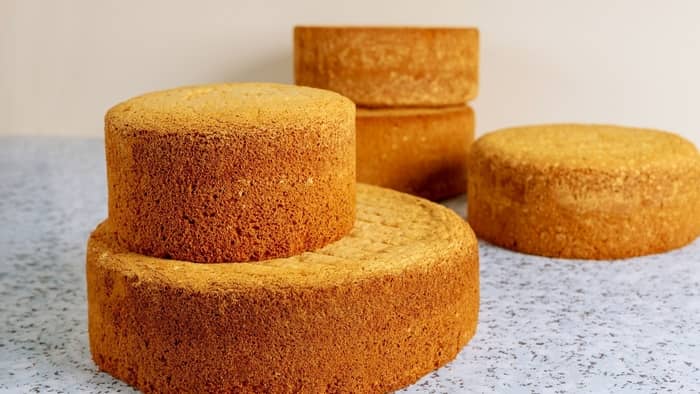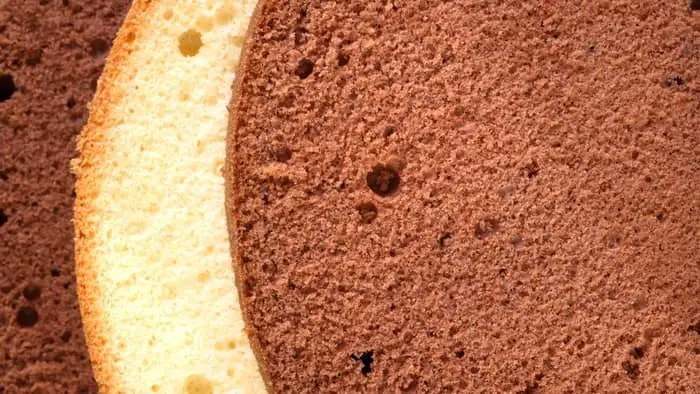Last Updated on July 19, 2022
Do you know what creates different cake textures? Today, we will explore 6 of the most common types and look at how to create them!
Today, cake lovers are chasing the ultimate texture. It even overshadows cake flavors these days! But, who can blame them? Have you ever tried a dry or rubbery slice of cake?
So, today we will be looking at the most common types of cake textures you will come across and their characteristics. Then, we will also explain what affects the texture of a cake so that you can prevent creating a texture you don’t want!
What Are The Different Cake Textures?
Let’s jump right into it! We have compiled a list of the 6 most common types of cake textures you will come across. Now, you may see that you recognize some of the cake types. That is because they are so unique that they qualify as a texture themselves.

Ready to get started?
Sponge cake
Sponge cake is arguably one of the most common cake textures you have. This is because most cake recipes are made using a sponging technique, hence the name.
Sponge cake has a soft and very light (almost airy) texture, but, it is a bit dry. These cakes don’t ever come out moist, and neither should they.
The dryness helps you to mold the cake, use it to stack layers, or make Swiss rolls. The texture will allow you to shape the layer while it still has enough strength to hold the weight of other ingredients.
Poundcake
Pound cake is another extremely common type of cake, often used to make molded or shaped cakes, stacked cakes, or bundt cakes.
Pound cakes are often denser than sponge cakes. They also have a fine crumb, but a much more crumbly texture in comparison. And, they have an incredibly melt-in-your-mouth feeling.
These cakes are often made using equal ratios of ingredients, which is where it gets its name from.
Moist
Yes, believe it or not, but this actually does classify as a type of texture. That is because, as you may know, and have personally experienced before, some cakes are extremely dry!
Moist cakes have a relatively tight crumb and are almost dense but in a moist way. It definitely does melt away in your mouth!
Moist cakes can either be made by using a higher liquid ingredient ratio (excluding eggs) or by specific baking and cooling techniques used.
Cream
These types of cakes are ones that are very soft, semi-moist, and which have a very minor chewy texture to them. They aren’t very dense.
But, they are excellent for slicing and hold very well. The mixing technique that is used to make this cake can give you a wide variety of products including muffins, cupcakes, some bundt cakes, cookies, and donuts.
Chiffon cake
We are obsessed with chiffon cakes. They are incredibly soft, airy, and moist. All thanks to the incredible mixing method used called a foaming method.
This method whips egg whites to create an airy texture and also uses very little (sometimes even no) fat. These cakes do not stack well and excessive weight will cause them to start denting.
Angel food cake
Angel food cake is another type of cake made using the foaming mixing technique to create different cake textures. So, naturally, it is also very light and airy.
The big difference between angel food cake and chiffon cake is that angel food cake does contain fat and has a chewier texture and coarser crumbs. It can definitely hold weight a lot better than chiffon cakes can.
Springform Cake Pan Set Of 3 (4 7 9 Inch)
What Affects The Texture Of Cakes?
Literally, every ingredient that you add to a cake recipe will in one way or another create different cake textures. It is actually pretty incredible when you think about it. This means, once you know what each ingredient does, you can manipulate the recipe and ratios to get the desired textures.
We will have a look at some of the major contributors that affect the texture of the cake.
Leavening agents
Okay, so while these ingredients usually don’t make up the bulk of a cake recipe, they arguably have the biggest effect on the final texture.
Leavening agents are there to help give rise to the cake. By doing so, they create a light and airy texture. Too little leavening and the cake will remain dense. However, if you add too much and there aren’t ingredients to help hold and support the lift, the cake will also fall flat and become dense.
Eggs
Eggs have a ton of functions in cakes. They help add richness, moisture, color, and even volume. If a cake recipe contains too many eggs, they create a mush instead of a batter. These cakes bake extremely dense and almost rubbery.
But, if you add the correct amount, they will create a nice fine crumb that can still be fluffy (because of the leavening agents used).
And, you can even whip the egg whites and fold them in to create super fluffy and airy cake textures.
Flour
Flour is crucially important in making different cake textures because it literally determines what type of texture your cake will have. There are different types of flours that have different purposes.
For example, bread flour has a high amount of gluten proteins, meaning they will create elastic bonds. Now, for cakes, you do not want this.
Instead, you want to use cake flour that has low gluten-forming abilities. This will give you a tight crumb that can be airy.
And, of course, if you use too much flour, it will create a very dense cake because there aren’t enough supporting ingredients to hold the weight.
Baking conditions
Now, while this isn’t an ingredient that affects the texture, using incorrect temperatures and times will also affect the texture your cake has. For example, baking at too high temperatures and for too long will dry out the cake, making it hard.
But, on the other hand, if you bake it at too low temperatures, it will fall flat because the structure isn’t set quickly enough to hold the weight of the leavened ingredients. So, your cake will be dense too.
Conclusion On Different Cake Textures

Hopefully, you have learned a thing or two about different cake textures that are out there and which ingredients play a role in creating them. This will enable you to change a recipe to create your own unique texture! Let us know in the comment below if you have any questions!
FAQs
How thick should cake batter be?
It depends of the type of cake your are making. Naturally, moist cakes will have a runnier batter because of the higher liquid content. But, in general, cake batters should never be stiff or watery.
What are the different textures of cake?
There are 6 main different types of cake textures. The name of the cake is also often used to describe a texture. So, for example, you get, chiffon cakes, angel food cakes, sponge cakes, pound cakes, and cream cakes, and moist cakes.
What is the texture of a perfect cake?
There is no "perfect" texture. But, there are unpleasant ones. We would say that any cake texture that is bland, dry, rubbery, and putty-like, isn't a good texture.

Lindy Van Schalkwyk is a culinary specialist with a background in Advanced Cooking, Advanced Pâtisserie, Media Communications and Nutrition. She has gained invaluable experience in the culinary industry having worked in some of the top restaurants in Africa in 2016 and 2017. Her expertise in nutrition has enabled her to develop recipes for special dietary needs. In 2018, Lindy began working in the Food Media industry, focusing on recipe development, recipe writing, food writing and food styling.


